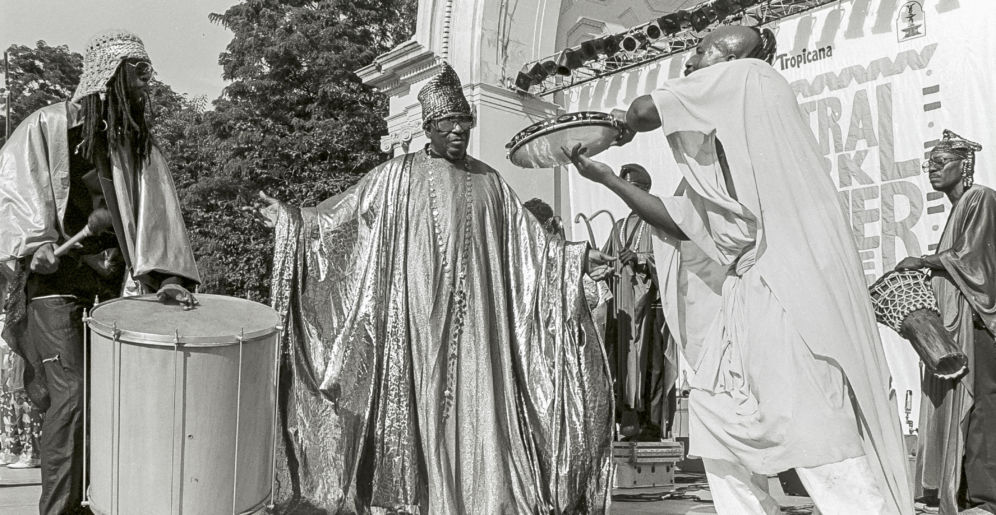
CultureMusic
sun ra altered the destiny for a generation of artists
The idea of space travel felt new for a little earthbound Black child like myself. The idea that there was a space right above my head, whose tonality mirrored my skin color — a sea of Blackness — where I could chase things more divine than what is on Earth — the planet rings, the stardust, and the all-encompassing darkness that would provide the backdrop to my cosmic adventure.
For as long as I can remember, Sun Ra was there to offer me the cosmos as a space for escape and perhaps for transcending a world whose anti-Blackness and gravity felt restrictive. Sun Ra offered the idea that there is no use for land, and I was committed to seeing this idea materialize in my own life.
On “Space is The Place,” one of his best known songs that is also the name of his classic cult-film, Sun Ra and the Arkestra delightfully moan and chant about space being the ultimate destination for Black folks. Again, my young mind was in the stars over the idea that there could be alternatives to the societal limits that my young self was experiencing in the terrestrial world.
The desire to transcend, to fly away into a great beyond is not new for Black folks. I recall Black mythology about enslaved African people flying away that was most popularly compiled by Virginia Hamilton in a collection entitled, The People Could Fly: American Black Folktales. One of these tales mirrors the story of the Igbo Landing — a mass suicide by enslaved Africans that collectively decided to drown themselves in the ocean to avoid the conditions of slavery. As above so below.
Sun Ra’s artistic legacy — art installations, films, and so much music that new recordings are still being unearthed — carries on these notions of transcendence. Of course, it might have been my own childhood naivete that caused me to believe he was speaking literally. Now, in adulthood, I understand that he might have been expressing in his own futuristic way the desire to not be in America.
Born Herman Blount in 1914, Sun Ra came to earth in Jim Crow-era Alabama, and felt the restrictive nature of this country early enough to daydream about dancing on Venus and Mars, and the need to escape into the stars. This need is why Nina Simone spent time in Ghana, where she reportedly lived some of her best life. This is why James Baldwin moved to Paris: to find relief and peace from a country that made terrorizing Black people not just routine, but constitutional. The desire to go to space might feel child-like and fantastical, but upon further investigation, you’ll realize that for a Black person that conclusion is predictable, even logical and pragmatic, if it weren’t for the lack of technology to realize it.
There was a seriousness to Sun Ra’s work and mission, including the work that had a sense of humor. It would be dishonest to say that what pulled myself (and a legion of other fans) towards Sun Ra was the fact that every surreal idea he offered felt realistic. But it was plausible, and with enough elbow grease and patience, it could be true. Personally, I embrace the intellectuality of Sun Ra’s metaphorical offering about space exploration and being from another planet — it’s something to interact with, but not take literally. A surreal idea that should help energize those consuming it to change our reality.
Yet inside of me, there is also a child that doesn’t want, or think it’s totally accurate, to dismiss and contextualize Sun Ra’s offerings as just dreams expressed through art. Deep down, I want to believe that Sun Ra believed in everything he created and said. Some consumers might feel like he was creating art, but Sun Ra believed he was creating scholarship and strategies for the great Black escape into space. I want to believe — even if my own Earthly limits prevent it — that Sun Ra was honestly trying to get his work to captivate, then infiltrate as many Black folks as possible. So that maybe his vision wouldn’t just be artistic, but political.
In 1979, during a talk in New York City, Sun Ra said, “If you can develop an atomic bomb, I’m sure you can develop an altered destiny.” Finding an answer to what parts of Sun Ra’s public existence was performance art and what he actually believed, is useless and misguided when tapping into why he remains such a powerhouse. Sun Ra’s most powerful offering to us all wasn’t actually an answer, but a question: Why not?
Get The Latest
Signup for the AFROPUNK newsletter



